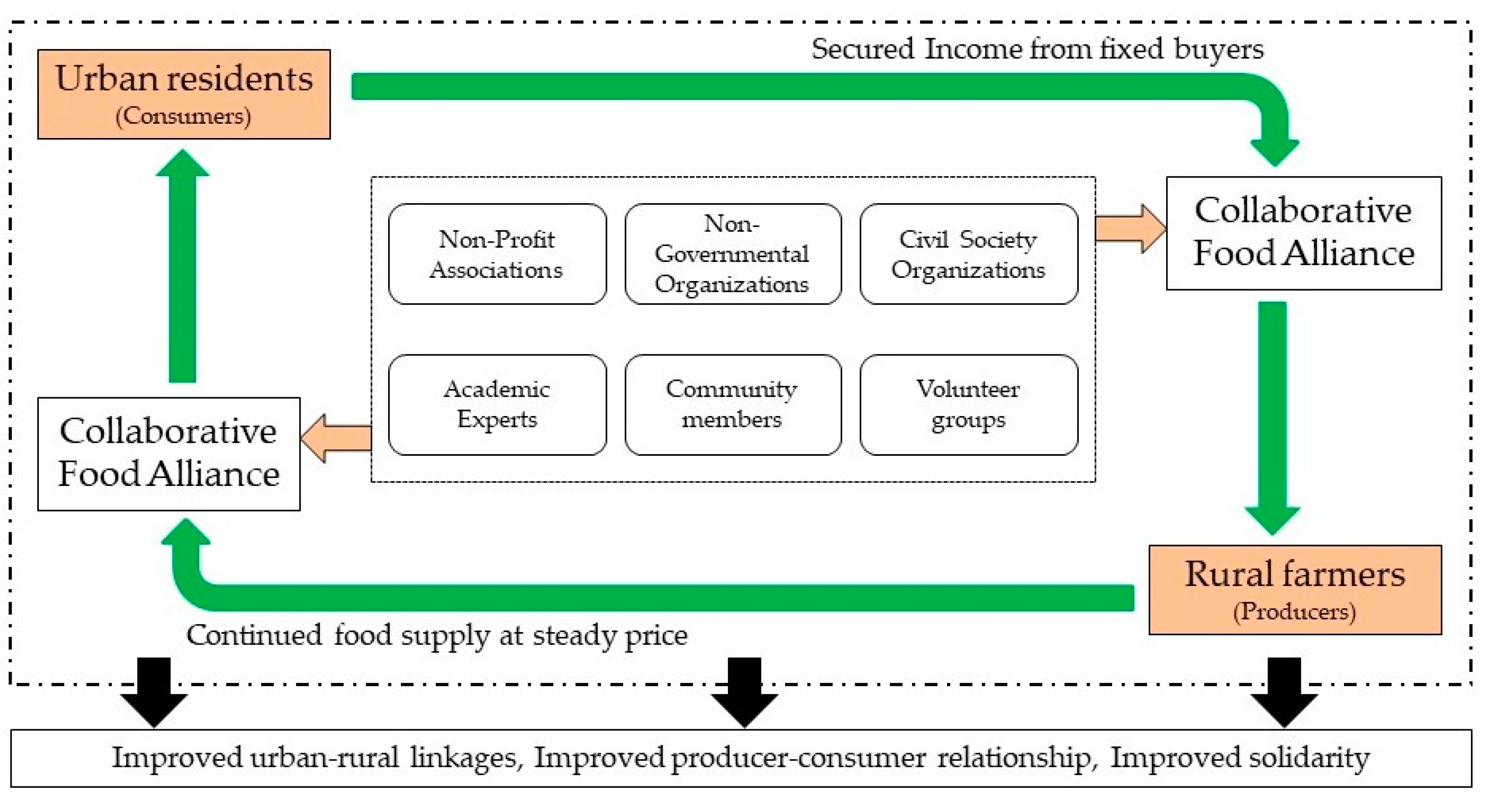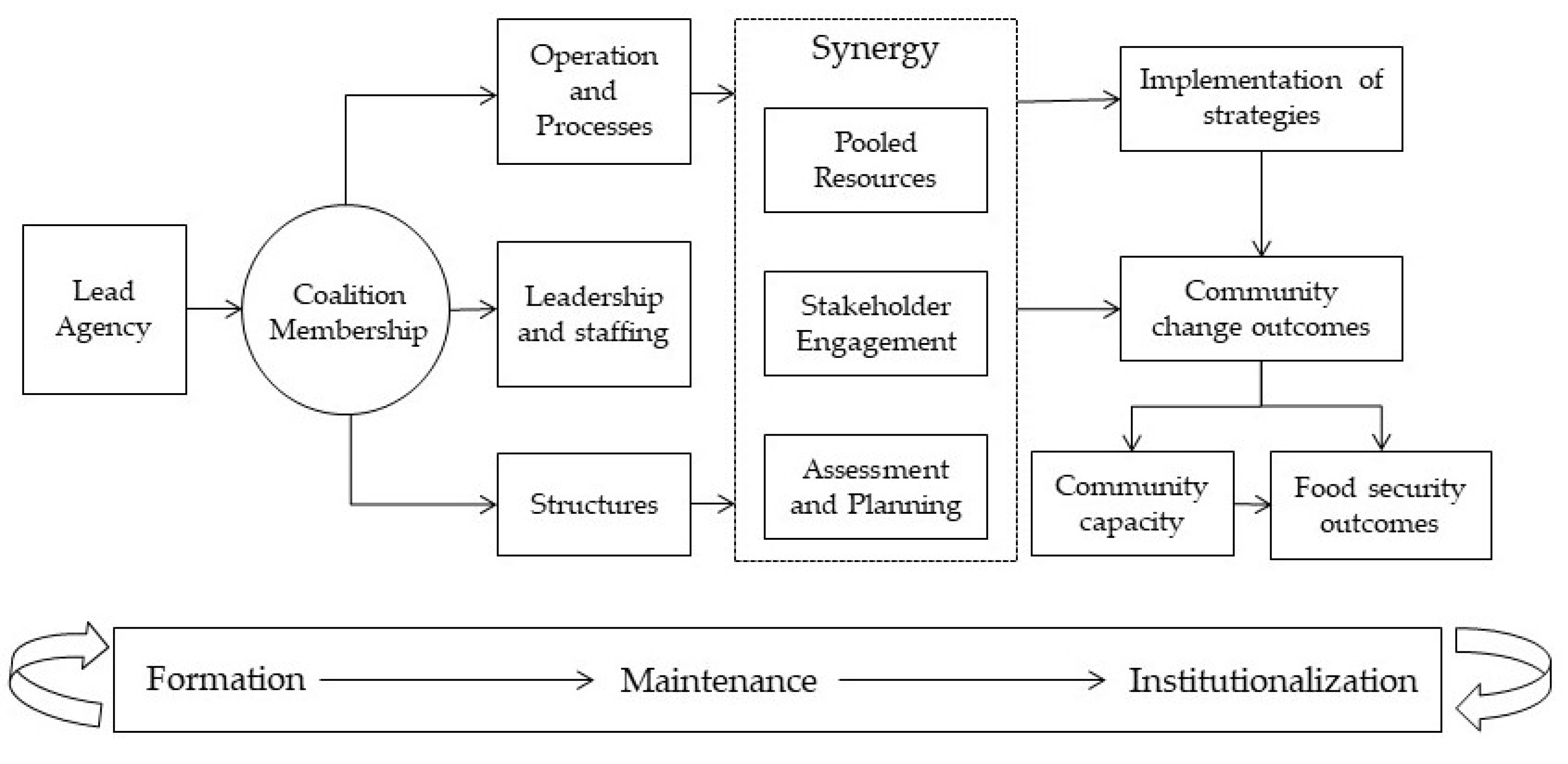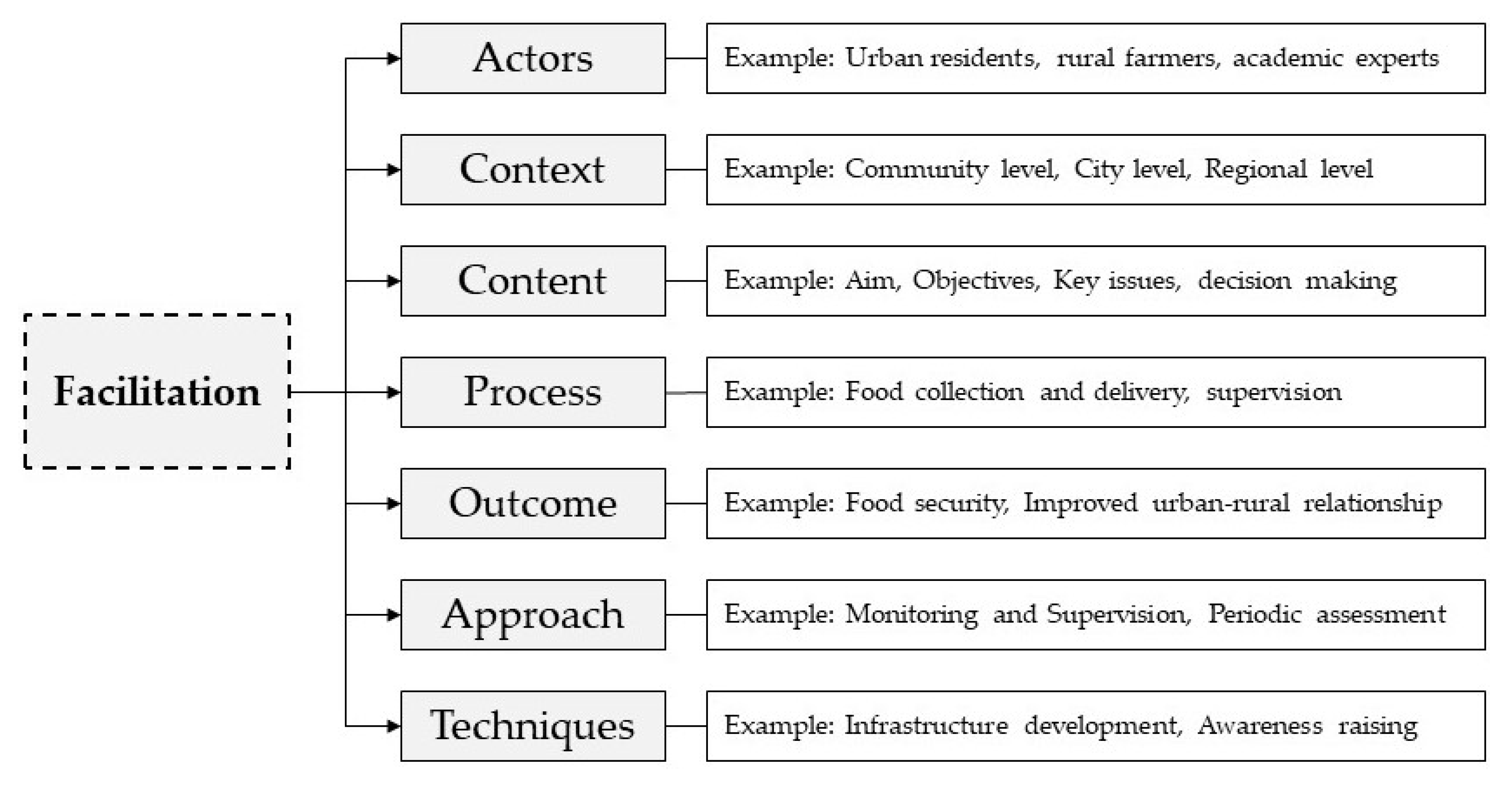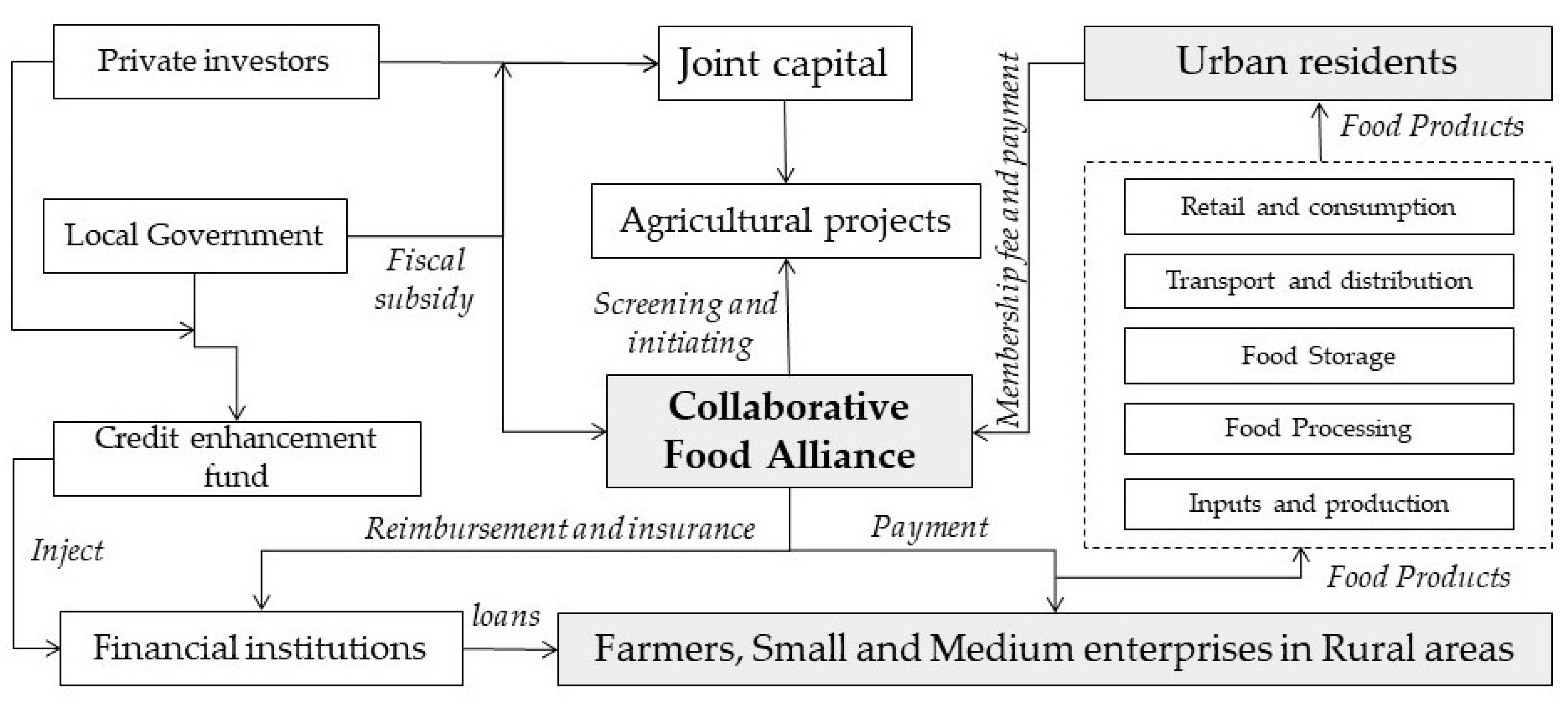Enhancing Food Security by Institutionalizing Collaborative Food Alliances in Urban Areas
Abstract
1. Introduction
2. Literature Review
2.1. Emerging Concerns in Food Systems Planning
- Increasing conversion of productive agricultural lands in urban and peri-urban surroundings.
- Increasing preferences for processed food products like meat, fats and oils, etc.
- Intensive use of natural resources which generate more greenhouse gas emissions.
- Weakening links between urban and rural areas and poor coordination at governance levels.
- Fragmented value chains and poor access to financing system.
2.2. Need for ‘City Region’ Perspective
2.3. Significance of Collaborative Food Alliances
3. Methodology
4. Institutionalizing Collaborative Food Alliances
- In the formation stage, the city governments will ensure that the main actors in food systems are brought together and they collectively recruit local representatives from urban and rural areas. The inclusion of local representatives will enhance trust and credibility of the coalition. Key leaders and selected staff members for the coalition building will then develop organizational structures and operating procedures for the CFAs. The structural divisions in the CFAs will make certain that the developed action plans adequately satisfy the core objectives of CFAs and effectively address the local food-related concerns.
- In the maintenance stage, the CFAs shall focus on developing synergy between the defined stakeholders. Resources from various partnering members of CFAs will be pooled to execute the strategic plans. Simultaneously, the stakeholders will engage in competent assessment and planning process for food ordering, delivery, accountability, payments etc. Thereafter, the members of CFAs will become engaged in implementing the intended strategies and fostering increased levels of participation through socialization and educational events. In the implementation stage, short term outcomes of enhancing individual knowledge as well as changes in community environment will be achieved.
- In the last stage of institutionalization, the successful strategies will result in desired outcomes at a community level. If the intended process of resource mobilization and strategy implementation effectively addresses the local needs, the coalition process will become institutionalized in the community long term. The maintenance and institutionalization stages will potentially enhance the community capacity to address food security issues.
5. Financing Mechanism to Support Collaborative Food Alliances
- The participating urban residents will deposit an annual membership fee alongside the required payments for food products and services, which will be utilized for the functioning of CFAs (manpower, space, etc.) as well as agricultural development in rural areas. In return, the participating urban residents will be assured a continuous supply of nutritious food at a steady price throughout the year.
- The participating rural farmers, small and medium enterprises will assure a continued food supply to urban areas through CFAs. In return, they will get a secured income and an eligibility certificate for special government subsidies in agricultural equipment, machinery, etc.
- The local governments will set up a credit enhancement fund in partnership with private companies to enhance the credit rating of the rural farmers and facilitate easy access to financial resources from lending institutions. As a complement of fund capital, the private investors shall get dividends earned through food transportation, storage, processing, etc. Further, in order to decrease the default risk of rural farmers, a fixed percentage of a farmer’s income generated through CFAs will be used to pay off their loans.
- The proposed CFAs, through means of exhibitions, workshops, seminars, field visits, etc., will provide a platform for the private companies to collaborate with urban–rural stakeholders involved in the food supply systems. In return, the participating private companies shall contribute to the joint capital (in the form of a Public–Private Partnership model) which would be utilized for agricultural development projects in rural areas (screened and initiated by institution of CFAs) including the construction of markets, logistics, green agriculture, etc.
6. Discussion and Conclusions
6.1. Enabling Multi-Stakeholder Engagement
6.2. Overcoming the Financial Constraints
6.3. Ensuring Policy Coordination at a Regional Level
Author Contributions
Funding
Acknowledgments
Conflicts of Interest
References
- United Nations, Department of Economic and Social Affairs, Population Division. World Urbanization Prospects: The 2014 Revision, Highlights; United Nations: New York, NY, USA, 2014; p. 32. [Google Scholar]
- Dubbeling, M.; Santini, G.; Renting, H.; Taguchi, M.; Lançon, L.; Zuluaga, J.; De Paoli, L.; Rodriguez, A.; Andino, V. Assessing and Planning Sustainable City Region Food Systems: Insights from Two Latin American Cities. Sustainability 2017, 9, 1455. [Google Scholar] [CrossRef]
- FAO. Food, Agriculture and Cities: Challenges of Food and Nutrition Security, Agriculture and Ecosystem Management in an Urbanizing World; Food and Agriculture Organization of the United Nations (FAO): Rome, Italy, 2011. [Google Scholar]
- International Food Policy Research Institute. 2017 Global Food Policy Report; International Food Policy Research Institute: Washington, DC, USA, 2017. [Google Scholar]
- FAO; IFAD; UNICEF; WFP; WHO. The State of Food Security and Nutrition in the World 2017. Building Resilience for Peace and Food Security; Food and Agriculture Organization of the United Nations (FAO): Rome, Italy, 2017. [Google Scholar]
- FAO; WFP; IFAD. The State of Food Insecurity in the World, Economic Growth Is Necessary but Not Sufficient to Accelerate Reduction of Hunger and Malnutrition; Food and Agriculture Organization of the United Nations (FAO): Rome, Italy, 2012. [Google Scholar]
- Leading Group. Innovative Financing for Agriculture, Food Security and Nutrition-Report of the High-Level Expert Committee to the Leading Group on Innovative Financing for Agriculture, Food Security and Nutrition. International Expert Report. 2012. Available online: http://www.leadinggroup.org (accessed on 17 February 2019).
- World Economic Forum. The Global Risks Report 2018 13th Edition; Insight Report; WEF: Geneva, Switzerland, 2018. [Google Scholar]
- FAO. ‘Rome Declaration on World Food Security and World Food Summit Plan of Action’, World Food Summit 13–17 November; Food and Agriculture Organization of the United Nations (FAO): Rome, Italy, 1996. [Google Scholar]
- FAO. The State of Food and Agriculture. Climate Change, Agriculture and Food Security; Food and Agriculture Organization of the United Nations (FAO): Rome, Italy, 2016. [Google Scholar]
- Preiss, P.; Charão-Marques, F.; Wiskerke, J.S.C. Fostering Sustainable Urban-Rural Linkages through Local Food Supply: A Transnational Analysis of Collaborative Food Alliances. Sustainability 2017, 9, 1155. [Google Scholar] [CrossRef]
- Khan, S.; Hanjra, M.A. Footprints of water and energy inputs in food production-Global perspectives. Food Policy 2009, 34, 130–140. [Google Scholar] [CrossRef]
- Jensen, J. Local and Regional Food Systems for Rural Futures; Rural Futures Lab. Foundation Paper No. 1; Rural Policy Research Institute (RUPRI): Iowa City, IA, USA, 2010. [Google Scholar]
- Foley, J.; Ramankutty, N.; Brauman, K.; Cassidy, E.; Gerber, J.; Johnston, M.; Mueller, N.; O’Connell, C.; Ray, D.K.; West, P.C.; et al. Solutions for a cultivated planet. Nature 2011, 478, 337–342. [Google Scholar] [CrossRef] [PubMed]
- Chkanikova, O. Sustainable Supply Chain Management in Food Retailing: Insights into Corporate Practice of Managing Supplier Relationships. Ph.D. Thesis, Lund University, Lund, Sweden, 2 December 2016. [Google Scholar]
- Sustainable Development Goals. Available online: https://sustainabledevelopment.un.org/?menu=1300 (accessed on 25 April 2019).
- Matuschke, I.; Kohler, S. Urbanization and Food Security. In WorldRiskReport 2014; Bündnis Entwicklung Hilft (Alliance Development Works): Bonn, Germany; United Nations University—Institute for Environment and Human Security (UNU-EHS): Berlin, Germany, 2014; p. 30. [Google Scholar]
- Van der Ploeg, J.D. Sete Teses Sobre a Agricultura Camponesa. Available online: https://www.researchgate.net/publication/283451041_Sete_teses_sobre_a_agricultura_camponesa (accessed on 2 July 2017).
- Renting, H.; Marsden, T.K.; Banks, J. Understanding alternative food networks: Exploring the role of short food supply chains in rural development. Environ. Plan. 2003, 35, 393–411. [Google Scholar] [CrossRef]
- Lutz, J.; Schachinger, J. Do Local Food Networks Foster Socio-Ecological Transitions towards Food Sovereignty? Learning from Real Place Experiences. Sustainability 2013, 5, 4778–4796. [Google Scholar] [CrossRef]
- Brinkley, C. The Small World of the Alternative Food Network. Sustainability 2018, 10, 2921. [Google Scholar] [CrossRef]
- De Bernardi, P.; Bertello, A.; Venuti, F. Online and On-Site Interactions within Alternative Food Networks: Sustainability Impact of Knowledge-Sharing Practices. Sustainability 2019, 11, 1457. [Google Scholar] [CrossRef]
- Renting, H.; Schermer, M.; Rossi, A. Building Food Democracy: Exploring Civic Food Networks and Newly Emerging Forms of Food Citizenship. Int. J. Soc. Agric. Food 2012, 19, 289–307. [Google Scholar]
- Spillare, S.; Paltrinieri, R.; Marciante, L. From Civic Food Networks to Civic Food Platforms: Collaboration, trust and empowerment in the New Food Economy. Sociol. Del Lav. 2018, 120–136. [Google Scholar] [CrossRef]
- Schönhart, M.; Penker, M.; Schmid, E. Sustainable local food production and consumption: Challenges for implementation and research. Outlook Agric. 2009, 38, 175–182. [Google Scholar] [CrossRef]
- Sbicca, J.; Luxton, I.; Hale, J.; Roeser, K. Collaborative Concession in Food Movement Networks: The Uneven Relations of Resource Mobilization. Sustainability 2019, 11, 2881. [Google Scholar] [CrossRef]
- Tregear, A. Progressing knowledge in alternative and local food networks: Critical reflections and a research agenda. J. Rural Stud. 2011, 27, 419–430. [Google Scholar] [CrossRef]
- Moragues Faus, A.; Sonnino, R. Re-assembling sustainable food cities: An exploration of translocal governance and its multiple agencies. Urban Stud. 2018, 56, 778–795. [Google Scholar] [CrossRef]
- Pinstrup-Andersen, P.; Watson, D.D. Food Policy for Developing Countries: The Role of Government in Global, National, and Local Food Systems; Cornell University Press: Ithaca, NY, USA, 2011. [Google Scholar]
- FAO. Sustainable Food Systems, Concept and Framework; Food and Agriculture Organization of the United Nations (FAO): Rome, Italy, 2018. [Google Scholar]
- De Schutter, O. Report of the Special Rapporteur on the Right to Food. Final Report: The Transformative Potential of the Right to Food; United Nations Human Rights Council: New York, NY, USA, 2014. [Google Scholar]
- De Schutter, O. The New Alliance for Food Security and Nutrition in Africa; European Union: Brussels, Belgium, 2015. [Google Scholar]
- De Schutter, O. The Green Rush: The Race for Farmland and the Rights of Land Users. Harv. Int. Law J. 2011, 52, 503–559. [Google Scholar]
- De Schutter, O. Special Rapporteur on the Right to Food, Food Commodities Speculation and Food Price Crises: Regulation to Reduce the Risks of Price Volatility; Special Rapporteur on the Right to Food Briefing Note No. 2; Office of the United Nations High Commissioner for Human Rights (OHCHR): Geneva, Switzerland, 2010. [Google Scholar]
- Milan Urban Food Policy Pact. Available online: http://www.milanurbanfoodpolicypact.org/ (accessed on 25 April 2019).
- The UN Decade of Action on Nutrition 2016–2025. Available online: https://www.unscn.org/en/topics/un-decade-of-action-on-nutrition (accessed on 25 April 2019).
- G7 Leaders Commit to Prioritize Global Nutrition. Available online: https://www.globalcitizen.org/en/content/g7-leaders-nutrition-food-hunger-global-goals/ (accessed on 30 May 2019).
- G20-2016-China, Focusing on Agricultural Innovation and Sustainable Development—Successful G20 Agriculture Ministers Meeting in Xi’an. Available online: http://www.g20chn.org/English/G20Priorities/Other/201609/t20160903_3307.html (accessed on 30 May 2019).
- The New Urban Agenda. Available online: http://habitat3.org/the-new-urban-agenda/ (accessed on 25 April 2019).
- Ruel, M.; Garrett, J.; Yosef, S. Food Security and Nutrition-Chapter 3, Growing Cities New Challenges. In 2017 Global Food Policy Report; International Food Policy Research Institute: Washington, DC, USA, 2017; pp. 24–32. [Google Scholar]
- Meybeck, A.; Burlingame, B.; Dernini, S.; Gitz, V.; Raymond, R.; Ryder, J. Improving Food Systems for Sustainable Diets in a Green Economy; Working Paper 4; Food and Agricultural Organization of the United Nations (FAO): Rome, Italy, 2012. [Google Scholar]
- Hussein, K.; Suttie, D. Rural-Urban Linkages and Food Systems in Sub-SAHARAN Africa, the Rural Dimension. 2016. Available online: https://ageconsearch.umn.edu/record/280043?ln=en (accessed on 27 May 2019).
- European Commission. The Economic Impact of Modern Retail on Choice and Innovation in the EU Food Sector; European Commission: Brussels, Belgium, 2014. [Google Scholar] [CrossRef]
- International Institute for Environment and Development. Fruitful Change: Rural-Urban Transformation in Vietnam’s Mekong Delta; IIED: London, UK, 2015. [Google Scholar]
- Committee on World Food Security. Addressing Food Security and Nutrition in the Context of Changing Rural-Urban Dynamics: Experiences and Effective Policy Approaches with Draft Decision; CFS: Rome, Italy, 2017. [Google Scholar]
- FAO. Smallholder INTEGRATION in changing Food Markets; Food and Agriculture Organization of the United Nations (FAO): Rome, Italy, 2013. [Google Scholar]
- Forster, T.; Escudero, G. City Regions as Landscapes for People, Food and Nature. EcoAgriculture Partners on Behalf of the Landscapes for People; Food and Nature Initiative: Washington, DC, USA, 2014. [Google Scholar]
- Food and Agriculture Organization of the United Nations (FAO). A Vision for City Region Food Systems, Building Sustainable and Resilient City Regions; RUAF Foundation: Leusden, The Netherlands, 2015. [Google Scholar]
- Food Alliance. Available online: http://foodalliance.org/about-us/history-of-food-alliance/ (accessed on 27 May 2019).
- Leat, P.; Revoredo-Giha, C.; Lamprinopoulou, C. Scotland’s Food and Drink Policy Discussion: Sustainability Issues in the Food Supply Chain. Sustainability 2011, 3, 605–631. [Google Scholar] [CrossRef]
- Butterfoss, F.; Kegler, M. Toward a Comprehensive Understanding of Community Coalitions: Moving from Practice to Theory. In Emerging Theories in Health Promotion Practice and Research, 2nd ed.; DiClemente, R.J., Crosby, R.A., Kegler, M.C., Eds.; John Wiley & Sons, Inc.: San Francisco, CA, USA, 2002; pp. 157–193. [Google Scholar]
- Papamichail, K.N.; Alves, G.; French, S.; Yang, J.B.; Snowdon, R. Facilitation practices in decision workshops. J. Oper. Res. Soc. 2007, 58, 614–632. [Google Scholar] [CrossRef]
- Sutherland, A. Challenges in institutionalising Farmer Participatory Research in the context of a more participatory agricultural research and extension system. In Proceedings of the Second Farmer Participatory Research Forum, Awassa, Ethiopia, 29 June–1 July 2000. [Google Scholar]
- Feighery, E.; Rogers, T. Building and Maintaining Effective Coalitions; Health Promotion Resource Center, Stanford Center for Research in Disease Prevention: Palo Alto, CA, USA, 1990. [Google Scholar]
- Whitt, M. Fighting Tobacco: A Coalition Approach to Improving Your Community’s Health; Michigan Department of Public Health: Lansing, MI, USA, 1993. [Google Scholar]
- Filippini, R.; Mazzocchi, C.; Corsi, S. The contribution of Urban Food Policies toward food security in developing and developed countries: A network analysis approach. Sustain. Cities Soc. 2019, 47, 101506. [Google Scholar] [CrossRef]
- Coulson, H.; Sonnino, R. Re-scaling the politics of food: Place-based urban food governance in the UK. Geoforum 2019, 98, 170–179. [Google Scholar] [CrossRef]
- FAO. The State of Food and Agriculture Leveraging Food Systems for Inclusive Rural Transformation; Food and Agriculture Organization of the United Nations (FAO): Rome, Italy, 2017. [Google Scholar]
- Neven, D.; Odera, M.M.; Reardon, T.; Wang, H. Kenyan supermarkets, emerging middle-class horticultural farmers, and employment impacts on the rural poor. World Dev. 2009, 37, 1802–1811. [Google Scholar] [CrossRef]
- Food Security Portal. The Global Food System and Employment. Available online: http://www.foodsecurityportal.org/global-food-system-and-employment (accessed on 8 July 2019).
- Fu, T.W.; Ke, M.C.; Huang, Y.S. Capital growth, financing source and profitability of small businesses: Evidence from Taiwan small enterprises. Small Bus. Econ. 2002, 18, 257–267. [Google Scholar] [CrossRef]
- Yurdakul, M.; Tansel, Y. AHP Approach in the Credit Evaluation of the Manufacturing Firms in Turkey. Int. J. Prod. Econ. 2004, 88, 269–289. [Google Scholar] [CrossRef]
- FAO. Sources of Funds for Agricultural Lending; Agricultural Finance Revisited No. 4; Food and Agriculture Organization of the United Nations (FAO) & Deutsche Gesellschaft für Technische Zusammenarbeit (GTZ): Rome, Italy, 1999. [Google Scholar]
- Girishankar, N. Innovating Development Finance-From Financing Sources to Financial Solutions; Policy Research Working Papers; The World Bank: Washington, DC, USA, 2009. [Google Scholar]




© 2019 by the authors. Licensee MDPI, Basel, Switzerland. This article is an open access article distributed under the terms and conditions of the Creative Commons Attribution (CC BY) license (http://creativecommons.org/licenses/by/4.0/).
Share and Cite
Sukhwani, V.; Nurzaman, A.; Kusumawardhani, N.P.; AlHinai, A.M.; Hanyu, L.; Shaw, R. Enhancing Food Security by Institutionalizing Collaborative Food Alliances in Urban Areas. Sustainability 2019, 11, 4103. https://doi.org/10.3390/su11154103
Sukhwani V, Nurzaman A, Kusumawardhani NP, AlHinai AM, Hanyu L, Shaw R. Enhancing Food Security by Institutionalizing Collaborative Food Alliances in Urban Areas. Sustainability. 2019; 11(15):4103. https://doi.org/10.3390/su11154103
Chicago/Turabian StyleSukhwani, Vibhas, Arie Nurzaman, Nadia Paramitha Kusumawardhani, Anwaar Mohammed AlHinai, Liu Hanyu, and Rajib Shaw. 2019. "Enhancing Food Security by Institutionalizing Collaborative Food Alliances in Urban Areas" Sustainability 11, no. 15: 4103. https://doi.org/10.3390/su11154103
APA StyleSukhwani, V., Nurzaman, A., Kusumawardhani, N. P., AlHinai, A. M., Hanyu, L., & Shaw, R. (2019). Enhancing Food Security by Institutionalizing Collaborative Food Alliances in Urban Areas. Sustainability, 11(15), 4103. https://doi.org/10.3390/su11154103






